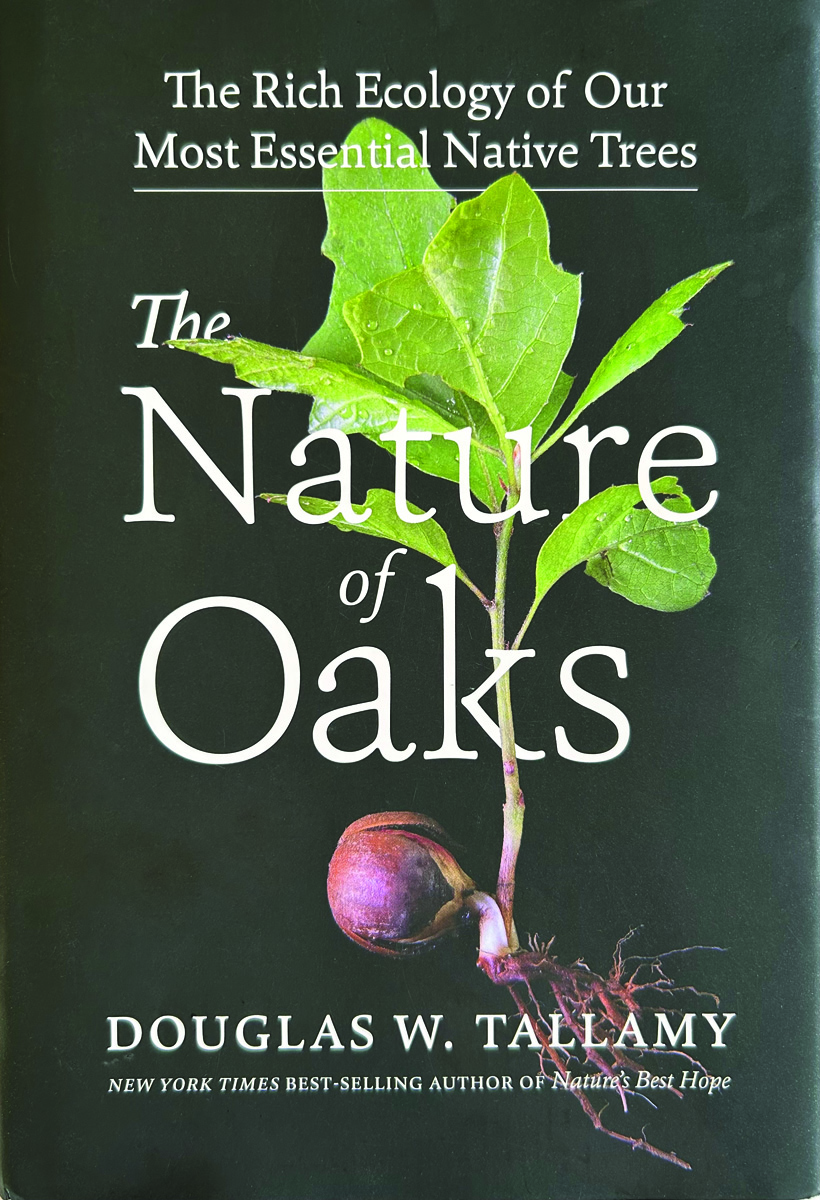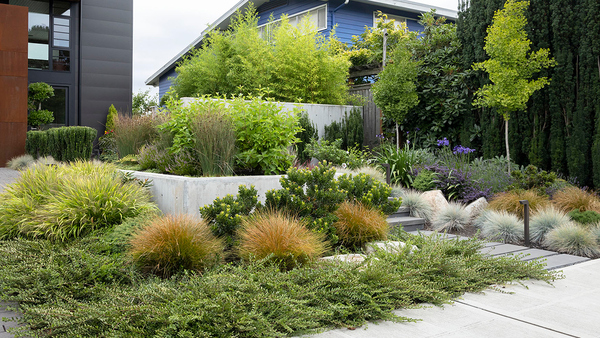
In the article 3 Steps to Get a Garden That Fills In Fast (Fine Gardening #208), garden designer Adam Woodruff takes readers through the steps he used to get a landscape that looked 10 years old in just three quick years. Adam used a matrix approach when selecting the plants that would fill his garden. The matrix-style is “meant to emulate naturally occurring plant communities where plants knit together and thrive to the exclusion of weeds, and in the long term it requires less maintenance than traditional planting schemes,” says Adam. This garden’s matrix-style planting is composed of more than 40 genera organized by their functional role: structural, seasonal theme, etc. Adam specifically selected plants that he had grown before but included a few that he had not grown. “It’s important the garden be successful, but it’s good to try some new things. I do this in most of my designs,” says Adam.
The process of laying out this meadow garden was precise. First to be installed were the woody plants (bones). Adam then focused on the ‘Caradonna’ salvia because it has a very strong form when in bloom. Then he moved on to placing some of the bigger structural plants. He started thinking about which plants would group nicely together. For instance, he saw a photo of sea lavender and tufted hair grass together and wondered, “What would look good emerging from that diaphanous mass? Perhaps, pale coneflower.” In some cases when Adam needed to select a plant that would fit nicely into a grouping of plants with similar conditional requirements, he’d choose a cultivar known to have a better habit or longer bloom time. For example, he chose ‘Azure Rush’ geranium because it’s less sprawling than Rozanne geranium (Geranium ‘Gerwat’, Zones 3–9).
Below is a comprehensive list of all the plants you’ll see in Adam’s meadow garden, organized by the matrix category they fall into.
Check out Adam’s 3 Tips for Evolving a Naturalized Garden Quickly

Plant Lists for Matrix Categories
Structural plants
- Korean angelica (Angelica gigas, Zones 4–9)
- ‘Vanilla Cream’ baptisia (Baptisia ‘Vanilla Cream’, Zones 3–9)
- Pale coneflower (Echinacea pallida, Zones 3–8)
- ‘Big Blue’ sea holly (Eryngium ‘Big Blue’, Zones 4–9)
- ‘Tawnt King’ red hot poker (Kniphofia ‘Tawny King’, Zones 6–9)
- ‘Transparent’ moor grass (Molinia caerulea ‘Transparent’, Zones 4–8)
- ‘Challenger’ culver’s root (Veronicastrum virginicum ‘Challenger’, Zones 3–8)
Seasonal theme plants
- ‘Hella Glashoff’ yarrow (Achillea ‘Hella Glashoff’, Zones 4–9)
- ‘Summer Beauty’ allium (Allium ‘Summer Beauty’, Zones 4–9)
- Butterfly weed (Asclepias tuberosa, Zones 3–9)
- ‘Little Carlow’ aster (Aster ‘Little Carlow’, Zones 4–8)
- ‘Montrose White’ calamint (Calamintha nepeta ‘Montrose White’, Zones 4–8)
- Carthusian pink (Dianthus carthusianorum, Zones 4–8)
- ‘Pow Wow White’ coneflower (Echinacea purpurea ‘Pow Wow White’, Zones 3–8)
- ‘Whirling Butterflies’ gaura (Gaura lindheimeri ‘Whirling Butterflies’, Zones 5–9)
- ‘Mai Tai’ geum (Geum ‘Mai Tai’, Zones 5–9)
- Sea lavender (Limonium latifolium, Zones 4–9)
- ‘Caradonna’ salvia (Salvia nemorosa ‘Caradonna’, Zones 4–8)
- ‘Hummelo’ betony (Stachys officinalis ‘Hummelo’, Zones 4–8)
- ‘Wedding Candles’ mullein (Verbascum chaixii ‘Wedding Candles’, Zones 5–9)
- ‘First Glory’ veronica (Veronica longifolia ‘First Glory’, Zones 4–8)
Ground-cover plants
- ‘Goldtau’ tufted hair grass (Deschampsia cespitosa ‘Goldtau’, Zones 4–8)
- Purple love grass (Eragrostis spectabilis, Zones 5–9)
- ‘Azure Rush’ geranium (Geranium ‘Azure Rush’, Zones 5–8)
- ‘Herrenhausen’ oregano (Origanum laevigatum ‘Herrenhausen’, Zones 5–9)
- Autumn moor grass (Sesleria autumnalis, Zones 5–9)
Filler plants
- Tuberose (Polianthes tuberosa, Zones 4–9)
- ‘Brazil’ tall verbena (Verbena bonariensis ‘Brazil’, Zones 7–11)
Scatter plants
- ‘Jowey Nicky’ dahlia (Dahlia ‘Jowey Nicky’, Zones 8–10)
- Tassel flower (Emilia javanica, annual)
- Langsdorff’s flowering tobacco (Nicotiana langsdorfii, annual)

Other plants featured (outside of matrix categories)
These species were all chosen for their excellent texture, structure, or seasonal appeal.
Ornamental grasses
- Quaking grass (Briza media, Zones 4–11)
- ‘Poul Petersen’ moor grass (Molinia ‘Poul Petersen’, Zones 4–8)
Trees/shrubs
- Bottlebrush buckeye (Aesculus parviflora, Zones 4-8)
- ‘Frans Fontaine’ hornbeam (Carpinus betulus ‘Frans Fontaine’, Zones 4–8)
- ‘Royal Purple’ smokebush (Cotinus coggygria ‘Royal Purple’, Zones 4–9)
- ‘Tardiva’ panicle hydrangea (Hydrangea paniculata ‘Tardiva’, Zones 3-9)
- Hick’s yew (Taxus × media ‘Hicksii’, Zones 5–8)
Bulbs
- ‘Spring Green’ tulip (Tulipa ‘Spring Green’, Zones 3–9)
- ‘Black Hero’ tulip (Tulipa ‘Black Hero’, Zones 3–9)
- ‘Paul Scherer’ tulip (Tulipa ‘Paul Scherer’, Zones 3–9)
- Paradox grape hyacinth (Muscari paradoxum, Zones 4–8)
- ‘Valerie Finnis’ grape hyacinth (Muscari armeniacum ‘Valerie Finnis’, Zones 4–8)
- Light blue allium (Allium caesium, Zones 4–7)
- Star of Persia (Allium cristophii, Zones 4–7)
- Drumstick allium (Allium sphaerocephalon, Zones 5–8)
- Sicilian honey garlic (Allium tripedale, Zones 4–8)
- Leichtlin’s camass (Camassia leichtlinii subsp. Suksdorfii, Zones 5–8)
Photos: Danielle Sherry
Fine Gardening Recommended Products

The Nature of Oaks: The Rich Ecology of Our Most Essential Native Trees
Fine Gardening receives a commission for items purchased through links on this site, including Amazon Associates and other affiliate advertising programs.

ARS Telescoping Long Reach Pruner
Fine Gardening receives a commission for items purchased through links on this site, including Amazon Associates and other affiliate advertising programs.


















Comments
Log in or create an account to post a comment.
Sign up Log in